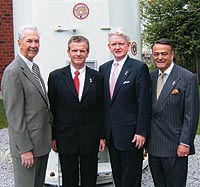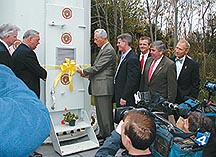September 2005 IBEW Journal
Skyward-gazing Boston-area commuters looked up one May
day and wondered whether it was a bird or a plane that moved in rhythmic cycles just off the Southeast Expressway in Dorchester. But four months after the big white windmill started churning, the 15-story turbine has become part of the New England landscape.
The wind turbine is only the latest renewable energy-generating technology to be added to Boston Local 103’s training center. Three years ago, the local installed a 5.4 kilowatt solar system on the center’s  roof. The local expanded from that initial foray into renewable energy technology to win work installing solar energy in commercial, industrial and residential buildings throughout eastern Massachusetts. roof. The local expanded from that initial foray into renewable energy technology to win work installing solar energy in commercial, industrial and residential buildings throughout eastern Massachusetts.
Local union leaders hope the windmill will bolster its reputation as green-friendly while helping train its apprentices and journeymen on a renewable energy source gaining in popularity around the country.
The high visibility location has already turned Local 103 into a de facto ambassador to the technology. Municipal officials, educational institutions and even private companies have made Local 103 leaders the go-to people for their expertise in the modern windmill.
The new Boston Local 103 windmill is located at the Local 103 training center on a busy expressway two miles south of downtown Boston.
“The perception is now that we’re the ones to call,” said Local 103 Business Agent Marty Aikens. “People say, ‘Get a hold of Local 103. Those union guys do it.’” Wind projects and interest in them are springing up across eastern Massachusetts. Leaders from the town of Hull recently consulted with IBEW leaders on a project for the municipal electric company. With one turbine now, one more going up early next year and three more on the drawing board, the town plans to generate most of its electricity by wind, Aikens said. The cities of Quincy, Marblehead and Gloucester are all interested in windmills.
Cape Cod Community College and the Massachusetts Maritime Academy have recently signed contracts to build turbines.
Local 103’s 149-foot tall, 100-kilowatt wind generator will produce enough electricity to power 35 homes annually, Aikens said. Local leaders expect the windmill to supply enough electricity to run 35 percent of the three-story training facility, which contains 20 classrooms, 10 shops, a boardroom and an auditorium. The solar panels are able to light five classrooms. But the primary purpose and greatest value of the turbine and solar panels is as a tool for teaching apprentices and members, Aikens said.
It took approximately six weeks to build the wind turbine, located on the grounds of the apprenticeship school two miles from downtown Boston. The biggest part of the job was the foundation, which involved drilling 85 feet underground, including 15 feet into bedrock, and installing six clay-filled casings to hold the shaft of the windmill’s tower in place. From there, it was a relatively quick three days to erect the tower and three-blade turbine. Then came the electrical wiring: installing the cables from the nascell—or the generator—to the foundation, and the data and speed controls.
“Local 103 has recognized the inevitability of the energy market shift away from fossil fuels and toward non-polluting renewable energy,” said Local 103 Business Manager Michael Monahan. “That presents our members with opportunities for jobs in emerging technologies.”
Aikens said the United States is on the verge of a shift away from foreign-supplied oil and greenhouse gas-emitting coal, and moving toward renewable energy. Like solar power, wind power takes advantage of a naturally occurring phenomenon.
“There’s no cost to run it—it’s just air. When it blows, it blows,” Aikens said. “We have been depending on fossil fuels for too long. Somewhere along the line, we’re going to have to get smart in this country,” Aikens said.
But traditional powerhouses will still be necessary for backup, like on heavy summer days when the air does not stir. August and September are typically the months with the least wind, Aikens said. The giant arms  of the windmill were stilled during portions of the summer, but the local took advantage of the summer doldrums by tweaking the brakes, tuning up the hydraulic equipment, testing the blade sensors and adjusting cables and software. of the windmill were stilled during portions of the summer, but the local took advantage of the summer doldrums by tweaking the brakes, tuning up the hydraulic equipment, testing the blade sensors and adjusting cables and software.
IBEW International President Edwin D. Hill, left, Local 103 Business Agent Marty Aikens, IBEW Second District Vice President Frank J. Carroll and Second District International Executive Council member Rui M. Carrinho, all wore Local 103 special-issue wind turbine pins on their lapels.
The turbine ran for 14 straight days in July, before shutting down due to lack of wind. As designed, the blades need winds of 8 or 9 miles an hour to start up, and they keep turning even if speeds subside to 5 or 6 miles an hour, Aikens said. The local has been working with the manufacturer to map the wind speeds and install software to program the turbine to auto-start at a steady wind speed of 5 mph.
Half of the $540,000 cost to install the turbine was picked up by a grant from the Massachusetts Technology Collaborative, which donated an additional $50,000 for education. Starting this fall, in addition to the solar courses at the Local 103 apprenticeship school, students will also have instruction in installing and maintaining the wind turbines, Aikens said. If the interest in the solar class is any indication, wind instruction will prove just as popular as the solar courses to journey-level electricians burnishing their credentials. Already, 400 Local 103 apprentices and more than 300 journeymen have taken the solar class, he said.
State and local governments are helping to fuel the rising popularity of wind energy by passing laws limiting power plant emissions, particularly those linked to global warning, like carbon dioxide. Texas will require 2,000 megawatts of its electricity be generated by renewables by 2009, New York mandated the increased use of renewables from 17 percent of the state’s electricity to 25 percent by 2012 and California aims to produce 20 percent of its electricity from renewable resources by 2017. A March report by the state government of New York estimated the mandate could generate 43,000 new jobs in manufacturing and energy industries and related increased economic activity. In all, 18 states and the District of Columbia have laws requiring the use of some renewable electricity generation.
From 2000 to 2004, wind energy increased 24 percent annually, representing one of the fastest-growing energy sources in the United States. The American Wind Energy Association predicts that wind energy can provide at least 6 percent of the nation’s electricity by 2020—enough to supply electricity to 25 million homes.
The impact on the country’s economy and job generation could be substantial, the association says. Billions of dollars have already been spent on investment and an estimated 150,000 jobs have been created. At least one blade manufacturer is responding to the growing need by opening facilities in the United States. In January, Spanish wind turbine maker Gamesa announced plans to build a plant in Pennsylvania and open a U.S. headquarters in Philadelphia, which will result in the creation of an estimated 1,000 new jobs in the state over five years.
Another boost for the wind industry came in the form of the energy bill, which President Bush signed in August. The legislation continues a tax credit of 1.9 cents per kilowatt hour for electricity generated with wind turbines over the first 10 years of a project’s operations. Now the credit—which had been scheduled to expire at the end of 2005—will be extended through 2007.
 At Boston Local 103’s official windmill dedication are IBEW Second District Vice President Frank J. Carroll, left, Boston Mayor Thomas M. Menino, IBEW President Edwin D. Hill, Local 103 Business Manager Michael P. Monahan, Local 103 Business Agent Marty Aikens, state Sen. Michael W. Morrisey and Renewable Energy Trust Executive Director Mitch Adams. At Boston Local 103’s official windmill dedication are IBEW Second District Vice President Frank J. Carroll, left, Boston Mayor Thomas M. Menino, IBEW President Edwin D. Hill, Local 103 Business Manager Michael P. Monahan, Local 103 Business Agent Marty Aikens, state Sen. Michael W. Morrisey and Renewable Energy Trust Executive Director Mitch Adams.
IBEW International President Edwin D. Hill joined the mayor of Boston and other officials in the dedication ceremony of the Local 103 windmill in May. “This wind turbine is a very important step, not just for the power it will generate, but because it shows that America is waking up to the fact that we need a multi-pronged approach to dealing with our energy issues,” President Hill said. “This ceremony is one more step in the direction of an America that has common sense at the heart of its energy policy.
”Local 103’s windmill also stands as a symbol of its support of the proposed Cape Wind project in Nantucket Sound, Aikens said. If the project goes forward, Local 103 would help build the 130 turbines in the ocean 7 to 10 miles off the Cape Cod shore.
North America is a long way from relying on renewable energy sources to replace fossil fuels. The IBEW’s approach is twofold: make sure that the transition does not have a sudden, negative impact on workers in the established energy industry, and prepare members for the jobs of the future.

|
